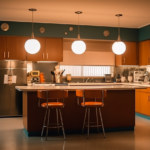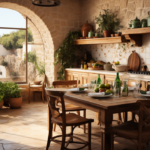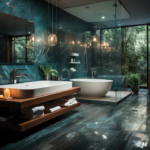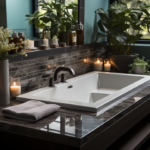Table of Contents
Conserving Water while Enhancing Style: Brilliant Bathroom Design Ideas
Hey there! Are you looking to revamp your bathroom and make it more environmentally friendly? Well, you’ve come to the right place! In this blog post, we’ll be diving into the world of designing a water-efficient bathroom, where we’ll explore some amazing improvement ideas that will not only help you save water but also add a touch of style to your space.
Nowadays, with water becoming an increasingly scarce resource, it’s important to make conscious choices when it comes to our everyday activities – and that includes using the bathroom. Reducing water consumption doesn’t mean compromising on functionality or aesthetics. In fact, it can be the perfect opportunity to unleash your creativity and transform your bathroom into a stunning oasis.
We’ll be exploring various design elements and practical strategies that can help you achieve a water-efficient bathroom that’s tailored to your personal taste. From installing low-flow fixtures and faucets to incorporating smart water-saving technologies, we’ll cover it all. But it doesn’t stop there! We’ll also look into creative ways to repurpose greywater, the power of dual-flush toilets, and the benefits of using eco-friendly materials.
So, whether you’re a sustainability enthusiast, a design aficionado, or simply looking to save some bucks on your water bill, join us on this exciting journey as we delve into the world of designing a water-efficient bathroom. Get ready to transform your space into a stylish, eco-conscious haven!
The Power of Low-Flow Fixtures and Faucets
Water-efficient fixtures and faucets are a game-changer when it comes to designing a water-efficient bathroom. These innovative fixtures are specifically designed to reduce water consumption without compromising on performance. Let’s explore the essential aspects of incorporating low-flow fixtures and faucets in your bathroom redesign:
- Toilets: Start by replacing your old water-guzzling toilet with a high-efficiency, dual-flush model. Dual-flush toilets offer two flushing options – one for liquid waste and another for solid waste, allowing you to choose the appropriate water flow for each use.
- Showerheads: Upgrade your shower with a low-flow or water-saving showerhead. These showerheads are designed to reduce water flow without compromising on the showering experience. You can opt for models that have adjustable spray settings for added convenience.
- Faucets: Replace traditional faucets with aerator-equipped ones. These aerators mix air with water, creating a steady flow while reducing water usage. You can also consider motion-sensor faucets that only release water when needed, preventing any wastage.
- Bathtubs: If you’re a bathtub lover, consider opting for a smaller, shallower model that requires less water to fill. Alternatively, you can embrace the luxurious trend of standalone showers, which are not only elegant but also more water-efficient.
By implementing these low-flow fixtures and faucets, you can significantly reduce your water consumption in the bathroom and contribute to conserving this precious resource. It’s a small change that can have a big impact on your monthly water bill.
Remember, it’s not just about saving water, but also about enhancing the overall look and feel of your bathroom. Many manufacturers now offer stylish and modern designs for water-efficient fixtures, allowing you to choose options that match your personal taste and decor.
So, why wait? Start exploring the world of low-flow fixtures and faucets to make your bathroom more water-efficient, cost-effective, and eco-friendly.
Embrace Smart Water-Saving Technologies
In this technologically advanced era, it’s exciting to see how smart devices and gadgets can contribute to a water-efficient bathroom. Here are some essential aspects to consider when embracing smart water-saving technologies in your bathroom design:
- Water-saving shower timers: Install smart shower timers that help track your water usage by providing alerts when you’ve exceeded a specific time limit. This way, you can become more aware of the amount of water you use during each shower.
- Smart leak detectors: Leaks can waste a significant amount of water without you even realizing it. By installing smart leak detectors, you’ll receive instant notifications on your phone if any leaks are detected, allowing you to take prompt action and prevent water wastage.
- Automated faucets: Upgrade your bathroom faucets to automated models that have motion sensors or touchless technology. These faucets only release water when they detect hands underneath, delivering water precisely when needed and reducing the chances of leaving the faucet running unintentionally.
- Smart water monitors: Utilize smart water monitoring systems that provide real-time data on your water usage. These devices can help you track your consumption, set goals for water-saving, and receive valuable insights to improve your bathroom habits and decrease water waste.
- Greywater recycling systems: Consider installing greywater recycling systems, which can collect and treat water from sinks, showers, and baths. This treated water can then be reused for flushing toilets or watering plants, reducing your reliance on fresh water sources.
Embracing these smart water-saving technologies can have a significant impact on reducing water consumption in your bathroom. Not only will they help you save water, but they also add convenience and bring your bathroom into the 21st century.
So, don’t shy away from incorporating these tech-savvy solutions into your water-efficient bathroom design. They not only make your life easier but also contribute to a more sustainable future. Embrace the power of smart water-saving technologies and take control of your bathroom’s water consumption!
Repurposing Greywater: Creative and Sustainable Solutions
When it comes to designing a water-efficient bathroom, repurposing greywater is a creative and sustainable solution that can make a significant impact on your water consumption. Here are some essential aspects to consider when implementing greywater systems:
- Greywater Basics: Greywater refers to the water from sinks, showers, and baths that can be reused instead of being sent down the drain. While not suitable for drinking or cooking, greywater can be repurposed for various non-potable uses, such as watering plants, flushing toilets, or even for outdoor irrigation.
- Greywater Diversion Systems: Install a greywater diversion system that collects and filters the water from your bathroom fixtures. These systems are designed to separate the greywater from blackwater (toilet waste), ensuring that only clean water is utilized for recycling purposes.
- Greywater-Friendly Plumbing: Consider some simple plumbing tweaks to make your bathroom more greywater-friendly. By connecting your sinks, showers, and bathtubs to a greywater collection system, you can redirect the water to desired areas such as a separate irrigation system or storage tanks for later use.
- Eco-friendly Detergents: When using greywater for watering plants, make sure to use eco-friendly and biodegradable detergents and soaps. Harsh chemicals can harm the soil and plants, so opt for natural alternatives that won’t negatively impact your garden.
- Local Regulations: Before implementing a greywater system, make sure to check local regulations and guidelines. Some areas may have specific rules regarding the collection, treatment, and usage of greywater. It’s important to comply with these regulations to ensure a safe and environmentally friendly system.
By reusing greywater in creative and sustainable ways, you can make a significant difference in your water consumption and minimize the strain on freshwater sources. Not only does it contribute to water conservation, but it can also reduce your water bill and nourish your plants.
So, don’t let your bathroom’s greywater go to waste. Explore the possibilities of repurposing this valuable resource and design a water-efficient bathroom that embraces sustainability and creativity. Together, we can make a difference, one drop at a time.
Dual-Flush Toilets: A Game-Changer in Water Conservation
When it comes to water-efficient bathroom design, dual-flush toilets are a true game-changer. They offer a smart and practical solution to minimize water wastage while maintaining optimal performance. Here’s why you should consider incorporating a dual-flush toilet in your bathroom:
- Two Flush Options: Dual-flush toilets come with two flushing options – one for liquid waste and another for solid waste. The liquid waste option uses less water, while the solid waste option provides a more powerful flush. This flexibility allows you to choose the appropriate water flow for each use, preventing unnecessary water usage.
- Water Savings: On average, traditional toilets use around 1.6 to 3 gallons of water per flush. In contrast, dual-flush toilets use significantly less water for liquid waste, typically around 0.8 to 1.1 gallons per flush. By using a dual-flush toilet, you can save gallons of water every day, making a substantial impact on your monthly water bill.
- Efficiency without Compromise: Dual-flush toilets are not just water-efficient; they also deliver excellent performance. The solid waste flush option ensures a powerful and thorough flush, eliminating the need for multiple flushes. So, you can enjoy the benefits of water savings without compromising on efficiency.
- Stylish Options: Dual-flush toilets come in various modern and stylish designs, allowing you to find one that perfectly matches your bathroom decor. From sleek and contemporary to classic and elegant, you can choose a dual-flush toilet that complements your overall bathroom design aesthetic.
By swapping out your old toilet for a dual-flush model, you’ll be making a notable difference in water conservation. Not only will you contribute to a more sustainable future, but you’ll also enjoy the benefits of reduced water consumption and lower utility bills.
So, why wait? Upgrade your bathroom’s toilet to a dual-flush model and make a significant impact on water conservation without sacrificing performance. It’s time to flush away water wastage and embrace the power of dual-flush toilets in designing a water-efficient bathroom!
Eco-Friendly Materials: Beautiful and Sustainable Choices
When designing a water-efficient bathroom, it’s not just about the fixtures and technologies you choose but also the materials you use. Opting for eco-friendly materials can enhance the sustainability of your bathroom while adding a touch of beauty. Here are some essential aspects to consider:
- Recycled Materials: Incorporate materials made from recycled content, such as recycled glass or recycled porcelain, for your countertops, tiles, and backsplashes. These materials prevent waste from entering landfills and give a second life to materials that might otherwise be discarded.
- Bamboo: Consider using bamboo for bathroom flooring, cabinets, or shelving. Bamboo is a rapidly renewable resource that grows quickly and doesn’t require the use of harmful chemicals for processing. It’s durable, stylish, and adds a natural touch to your bathroom.
- Low VOC Paint: When painting your bathroom walls, choose low or zero volatile organic compound (VOC) paint. Conventional paints can release harmful chemicals into the air, contributing to indoor air pollution. Low VOC paint reduces these emissions, creating a healthier and more environmentally friendly bathroom.
- Water-resistant Sustainable Wood: If you prefer a more traditional look, select water-resistant, sustainably sourced wood for your bathroom cabinets, vanities, or accents. Look for certifications such as FSC (Forest Stewardship Council) or SFI (Sustainable Forestry Initiative) to ensure responsible forest management.
- Natural Stone: For a touch of elegance, choose natural stone tiles or countertops. Opt for varieties like marble or granite that are sustainably sourced and have a long lifespan. Natural stone not only adds beauty but also reduces the need for frequent replacements.
By selecting eco-friendly materials, you can create a bathroom that showcases your design aesthetic while minimizing environmental impact. These materials are not only sustainable choices but often have superior durability, ensuring your bathroom stands the test of time.
So, step away from conventional materials and embrace the beauty of eco-friendly options in your water-efficient bathroom design. Let Mother Nature inspire you, and make a positive impact on the environment while creating a stunning space you’ll love for years to come.
Creative Storage Solutions for a Clutter-Free Bathroom
Designing a water-efficient bathroom goes beyond just water-saving fixtures and materials. Creating a clutter-free space can also contribute to a more functional and visually appealing bathroom. Here are some essential aspects to consider when implementing creative storage solutions:
- Vanity with Drawers: Opt for a vanity with ample drawer space to keep your bathroom essentials organized and out of sight. Utilize drawer dividers to separate items like toiletries, cosmetics, and cleaning supplies for easy access and maximum efficiency.
- Floating Shelves: Install floating shelves on the walls to effectively utilize vertical space. This provides a stylish and convenient way to store towels, containers, and decorative items, keeping them within reach while freeing up valuable counter space.
- Over-the-Toilet Storage: Take advantage of the often underutilized space above the toilet by installing shelves or cabinets. This area can accommodate items like extra toilet paper, towels, or decorative baskets to store smaller essentials.
- Baskets and Bins: Invest in decorative baskets or bins to corral items and create a more organized look. These can be placed on open shelves or under the sink to hold towels, toiletries, or cleaning supplies, minimizing clutter and adding visual appeal.
- Medicine Cabinets with Built-in Mirrors: Consider medicine cabinets with built-in mirrors that offer concealed storage. These cabinets are perfect for storing medications, personal care items, and other small accessories, eliminating countertop clutter.
By implementing these creative storage solutions, you’ll maximize space utilization and keep your bathroom tidy and streamlined. A clutter-free environment not only enhances the overall aesthetic but also makes it easier to maintain cleanliness and promotes a sense of calm and relaxation.
So, think beyond the traditional storage options and get creative with your bathroom storage. From stylish vanities with ample drawers to floating shelves and decorative baskets, choose solutions that fit your style while keeping your bathroom organized and inviting. Embrace the art of decluttering and embark on your journey to a water-efficient and clutter-free bathroom.
Efficient Lighting: Illuminate Responsibly
When designing a water-efficient bathroom, it’s important not to overlook the lighting aspect. By choosing efficient lighting options, you can reduce energy consumption and create a sustainable and inviting space. Here are some essential aspects to consider:
- LED Lighting: Opt for LED (Light Emitting Diode) lighting throughout your bathroom. LED bulbs are energy-efficient, have a longer lifespan, and provide excellent illumination. They consume significantly less energy compared to traditional incandescent or fluorescent bulbs, saving you money on your electricity bill.
- Natural Light: Make the most of natural light by incorporating windows, skylights, or light tubes in your bathroom. Natural light not only provides a beautiful and refreshing ambiance, but it also eliminates the need for artificial lighting during the day, reducing energy usage.
- Dimmer Switches: Install dimmer switches for your bathroom lights. Dimmers allow you to adjust the brightness according to your needs, creating a relaxed and cozy atmosphere when desired. This not only saves energy but also adds a touch of versatility to your lighting.
- Task Lighting: Use task lighting strategically to provide focused illumination in specific areas, such as above the mirror or near the vanity. Installing LEDs or low-wattage bulbs in these areas ensures adequate lighting for grooming or applying makeup while minimizing energy consumption.
- Motion Sensors: Consider using motion sensor lighting in areas like the hallway or powder room. These sensors detect movement and automatically turn on and off the lights, preventing unnecessary energy wastage when the rooms are not in use.
By embracing efficient lighting options, you can reduce your carbon footprint and contribute to a more environmentally friendly bathroom. Not only will you save energy and reduce your impact on the planet, but you’ll also create a well-lit and inviting space for your daily routines.
So, focus on illuminating responsibly by choosing LED lighting, maximizing natural light, utilizing dimmer switches, incorporating task lighting, and integrating motion sensors. Let your bathroom shine bright while being mindful of energy efficiency. It’s time to light up your water-efficient bathroom with smart and sustainable lighting choices!
Incorporating Natural Elements for a Serene Bathroom Retreat
When designing a water-efficient bathroom, don’t forget to bring the beauty and tranquility of nature indoors. By incorporating natural elements, you can create a serene and peaceful bathroom retreat. Here are some essential aspects to consider:
- Plants: Add greenery to your bathroom with indoor plants that thrive in humid environments. Plants not only improve air quality but also create a soothing and calming atmosphere. Choose low-maintenance varieties like pothos, snake plants, or ferns that require minimal watering.
- Natural Materials: Opt for bathroom fixtures and accessories made from natural materials like stone, wood, or bamboo. These materials not only have a timeless appeal but also provide a sense of warmth and connection to nature. Consider using natural stone for countertops, wooden accents for cabinets, and bamboo bath accessories.
- Organic Textiles: Choose organic and sustainable textiles for your bath linens and shower curtains. Look for options made from organic cotton, hemp, or bamboo fibers. These materials are not only gentle on the planet but also provide a luxurious and spa-like feel to your bathroom.
- Neutral Color Palette: Embrace a neutral color palette inspired by nature. Soft blues, earthy browns, and pastel greens can evoke a sense of calmness and tranquility. Use these colors on the walls, tiles, and accessories to create a harmonious and peaceful atmosphere.
- Natural Light and Views: Maximize natural light and views if possible. Install large windows or skylights to let in ample sunlight and provide glimpses of the outside world. If privacy is a concern, consider using frosted glass or window treatments that still allow natural light to filter through.
By incorporating natural elements, you can create a bathroom that feels like a sanctuary, offering a peaceful retreat from the outside world. The combination of plants, natural materials, organic textiles, a soothing color palette, and an abundance of natural light will transform your bathroom into a serene oasis.
So, embrace nature’s influence and bring it into your water-efficient bathroom. Let the calming presence of natural elements create a peaceful ambiance that helps you unwind and rejuvenate. Design a bathroom retreat that not only conserves water but also nourishes your soul.
The Magic of Water-Efficient Showerheads
When it comes to designing a water-efficient bathroom, one of the most significant improvements you can make is choosing water-efficient showerheads. These magical devices can not only help you conserve water but also provide a wonderful showering experience. Here’s why you should consider water-efficient showerheads:
- Reduced Water Consumption: Water-efficient showerheads are designed to limit water flow while still delivering a satisfying shower. They use innovative technology to maintain adequate pressure while consuming fewer gallons per minute. By switching to a water-efficient showerhead, you can save a substantial amount of water with each use.
- Preserved Showering Experience: Don’t worry about sacrificing your showering experience. Water-efficient showerheads utilize features like aerators, pressure regulators, or air-injection technology to enhance the feeling of water flow. You’ll still enjoy a refreshing and invigorating shower while using less water.
- Savings on Water Bills: By cutting down water usage, water-efficient showerheads can significantly lower your water bills. Every drop of water saved adds up in the long run, making an impact on both the environment and your wallet. It’s a win-win situation!
- Easy Installation: Swapping out your old showerhead for a water-efficient one is a simple and straightforward process. Most models can be easily installed without the need for professional assistance. Just unscrew the old showerhead, apply some plumber’s tape to the threaded pipe, and screw on the new water-efficient showerhead.
- Wide Variety of Choices: Water-efficient showerheads come in a wide range of styles, finishes, and features to suit every preference. From traditional fixed showerheads to handheld options, you’ll find a showerhead that matches your bathroom aesthetic while conserving water.
So, make the switch to water-efficient showerheads and contribute to water conservation without compromising on your showering experience. It’s an easy and effective way to design a water-efficient bathroom that aligns with your sustainable lifestyle.
Say goodbye to water wastage and hello to an enjoyable showering ritual that saves both water and money. Install a water-efficient showerhead and indulge in guilt-free showers while doing your part for the planet.
Maximizing Space and Functionality in a Compact Bathroom
Designing a water-efficient bathroom doesn’t have to be a challenge, even if you’re working with a small space. By maximizing space and functionality, you can create a bathroom that feels open, organized, and efficient. Here are some essential aspects to consider:
- Smart Storage Solutions: Utilize every inch of available space by incorporating smart storage solutions. Install wall-mounted shelves, hanging baskets, or built-in cabinets to keep your bathroom essentials neatly organized and easily accessible. Consider installing a vanity with built-in storage or adding shelves above the toilet for extra space.
- Mirrors and Lighting: Use mirrors strategically to create the illusion of a larger space. Place a large mirror above the vanity to reflect light and give the impression of depth. Additionally, ensure ample lighting to brighten up the bathroom and make it feel more open. Add task lighting for functionality and consider incorporating natural light if possible.
- Compact Fixtures and Fittings: Opt for compact fixtures and fittings specifically designed for small bathrooms. Look for space-saving toilets with narrower tanks, corner sinks, or pedestal sinks that occupy less floor space. Consider a walk-in shower or a smaller bathtub to maximize the available area.
- Clear Shower Enclosures: If you have a shower stall, opt for clear glass enclosures instead of opaque ones. Clear glass visually expands the space and creates an open, airy feel. It allows natural light to penetrate and gives the illusion of a larger bathroom, making it feel less cramped.
- Vertical Storage: Maximize vertical space by installing high shelves or cabinets that reach up to the ceiling. Use these areas to store less frequently used items or items that are not sensitive to humidity. This helps to free up valuable floor space and keeps your bathroom clutter-free.
By implementing these space-saving techniques, you can transform a compact bathroom into a functional and inviting space. Remember, it’s not about the size of the bathroom but how effectively you use the available space.
So, embrace the challenge of a small bathroom and design a water-efficient space that is both practical and visually appealing. Maximize every nook and cranny, and create a bathroom that feels open, organized, and comfortable, no matter its size.
Conclusion
In conclusion, designing a water-efficient bathroom doesn’t have to be complicated or boring. With the right improvement ideas, you can create a space that not only conserves water but also reflects your personal style and provides a relaxing oasis. From incorporating low-flow fixtures and faucets to embracing smart water-saving technologies, there are numerous ways to make your bathroom more eco-friendly. Additionally, repurposing greywater, installing dual-flush toilets, choosing eco-friendly materials, and maximizing storage and functionality will further enhance the sustainability and usability of your bathroom. Remember to also pay attention to efficient lighting, incorporate natural elements, and consider the magic of water-efficient showerheads. Lastly, whether you have a large bathroom or a compact one, there are always ways to make the most of the available space and create a water-efficient, functional, and beautiful bathroom. So, go ahead and embark on this exciting journey of designing a water-efficient bathroom. Not only will you contribute to water conservation and reduce your environmental impact, but you’ll also create a space that brings joy, relaxation, and serenity to your daily routines.









